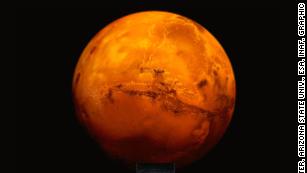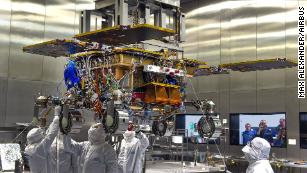Martian landslides may be caused by melting ice and salt under the surface
(CNN)Mars may seem like a still, frozen desert, but more evidence suggests that the red planet is active in subtle ways.
The NASA InSight mission has helped researchers determine that the planet experiences Marsquakes, making it seismically active.
And
then there is the mystery of Recurring Slope Lineae, known as RSL, that
have intrigued scientists for years. These RSL are a form of landslide
on Mars, but no one knows what causes them, said Janice Bishop, author
of a new study on the phenomena.
"We
see them from orbit by the dark streaks they produce on the ground and
they tend to always occur on sun-facing slopes, which led geologists to
think they were related to melting ice early on," said Bishop, senior
research scientist at the SETI Institute in California.
"The
interesting thing is that they increase over months following dust
storms and then fade away, and they appear to form repeatedly in the
same regions. Also, a large number of these are forming in the
equatorial part of Mars, where there is very little ice."
Any ice in these regions would have to be in tiny frozen particles that exist between grains of soil below the surface.
These
puzzling landslides have never been seen up close by a rover or lander,
and until they can be investigated by a robotic explorer, scientists
are using lab experiments and Martian analogs on Earth to try and
understand them.
Some
of the strange environments on Earth that are similar to that of Mars
include the Atacama desert in Chile, parts of Antarctica and even the
Dead Sea. These places show that surface collapse and landslides occur
when salt interacts with sulfates or water underground.
"Antarctica
and the Atacama are excellent analogs for Mars because they are ultra
dry environments," Bishop said. "Antarctica has the added benefit that
it is super cold. Parts of Antarctica including Beacon Valley are
actually on par with Mars for temperature and aridity."
While
water may have once been plentiful on the Martian surface billions of
years ago, when the planet was warmer and still retained most of its
atmosphere, the current surface of Mars is a freezing cold and barren
landscape.
What lies beneath
However,
Mars missions and imaging by orbiters have revealed that frozen salty
water is below the surface -- and that water could be driving activity
that appears on the Martian surface, like the landslides.
Bishop
and her colleagues collected samples from some similar environments on
Earth, including Wright Valley in Antarctica, to test how salts and
melting ice underground could cause chemical reactions that trigger
these seasonal landslides on Mars. The researchers wanted to test if
processes observed in places like Antarctica, where salty sediments can
have an effect on surface soil, could be happening on Mars.
The
scientists modeled the briny water beneath the surface of Mars in a lab
by taking the collected soil samples and exposing them to water and
chlorine salts and sulfates -- all of which could exist beneath the
Martian surface. This experiment resulted in the creation of thin,
moving films of slushy water.
To
model Martian temperatures where ice exists beneath the surface at the
planet's mid-latitudes, the researchers found slushy ice formed near
negative 58 degrees Fahrenheit and a slow, gradual melting of the ice
between negative 40 degrees Fahrenheit and negative 4 degrees
Fahrenheit.
These
temperatures may sound cold, but on Mars, they're actually considered
to be slightly warmer temperatures found near the equator -- which could
support briny water beneath the surface in the Martian spring and
summer.
If
this subsurface brine on Mars expands and contracts over time on Mars,
it could weaken the surface and cause sinkholes, ground collapse and
landslides.
Previously,
scientists believed that flows of liquid debris or dry grainy material
could be causing the landslides, but neither completely matched up with
what scientists saw in the RSL.
However,
if ice is melting just beneath the surface, that change would also
alter the surface itself. The Martian surface is also at the mercy of
wind and seasonal dust storms, which could also play a part in this
phenomenon.
"During
my fieldwork at Salar de Pajonales, a dry salt bed in Northern Chile, I
have observed numerous examples of the action of salts on the local
geology. It's gratifying to find that it could play a role in shaping
Mars as well," said study coauthor Nancy Hinman, a professor of
geosciences at the University of Montana, in a statement.
The study published Wednesday in the journal Science Advances.
Chemical activity
"If
our hypothesis is correct, then RSL could be indicators for salts on
Mars and for near-surface active chemistry," Bishop said. "Most of us
Mars scientists have considered modern Mars as a cold and dry and
dormant place, shaped mostly by dust storms. This is certainly true of
the surface, but our work shows that the subsurface could be much more
chemically active than realized before."
Bishop noted that this underground process that could result in landslides on the surface would be a slow and limited one.
While
this brine would be too salty to support life, the experiments in the
study support the idea that this subsurface liquid water can actually
move around the salt and mineral grains. If that's the case, water on
Mars 4 billion years ago could have filtered down into the subsurface as
a type of permafrost soil. This ice could have thawed and refrozen over
time.
"It
could be that more of this early water on Mars persisted longer than we
realized below the surface," Bishop said. "If true, this could indicate
that the subsurface of Mars was habitable longer than the surface
environment. It is difficult to estimate how long, but perhaps liquid
water was present around soil grains below the surface until 3 or 2
billion years ago or even more recently."
Previous research has also suggested that the most habitable part of Mars actually lies beneath its surface.
Future robotic explorers, like the European Space Agency's Rosalind Franklin rover scheduled to launch in 2022, can drill beneath the surface and investigate what's going on.
"Once
we send rovers to Mars that can drill down into the surface, I think we
will see signs of salt reactions below the surface -- especially if we
investigate some of the equatorial regions where RSL are occurring,"














No comments